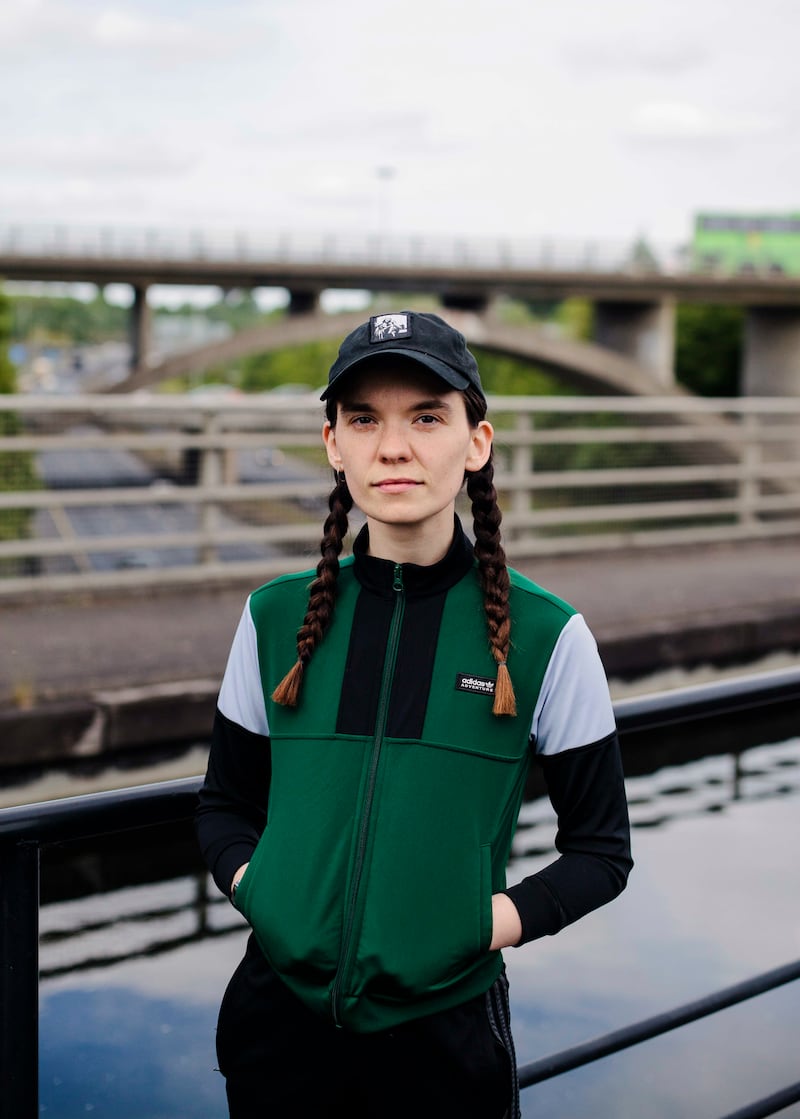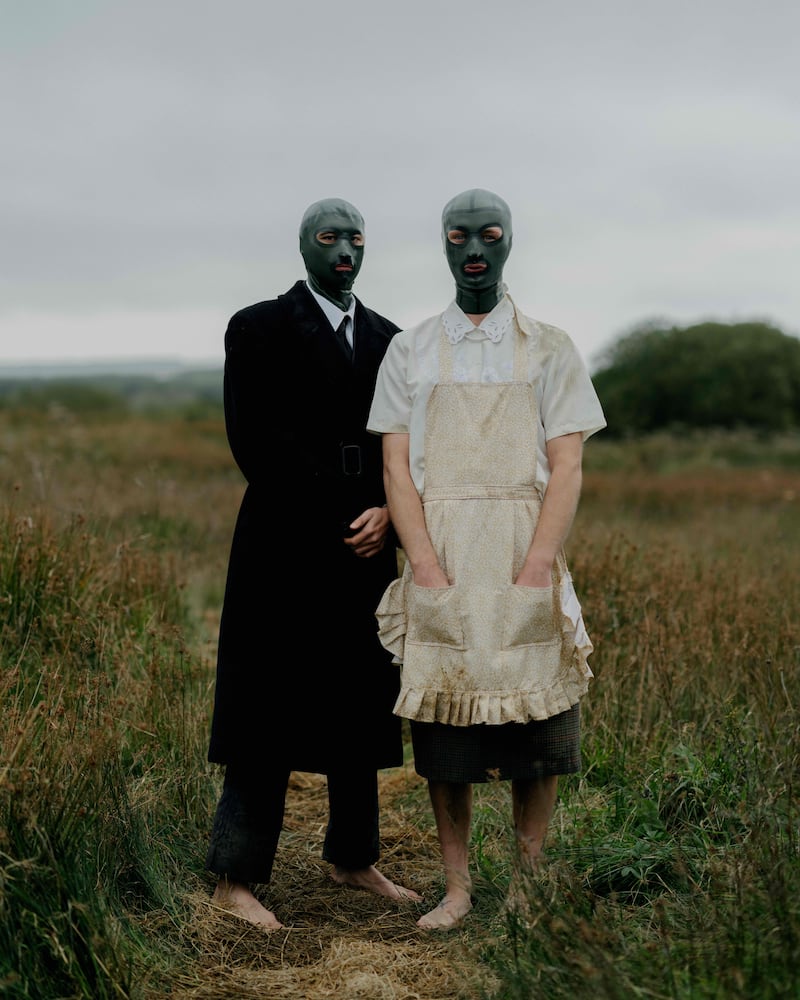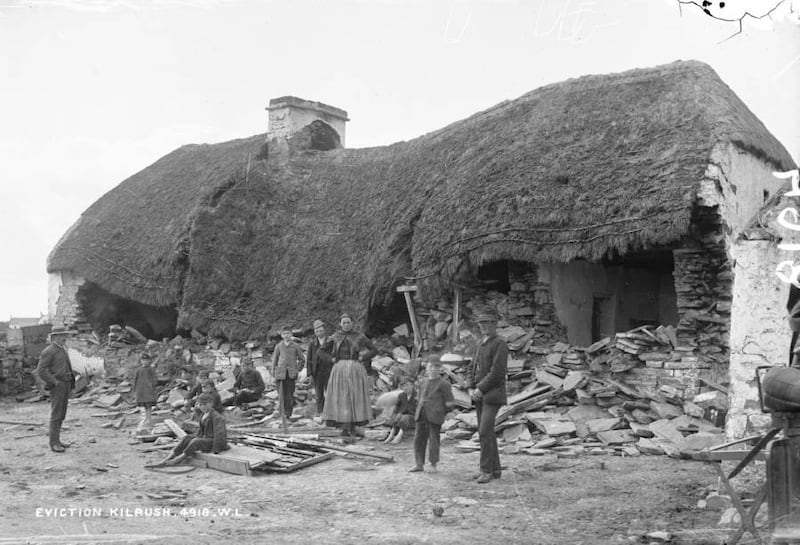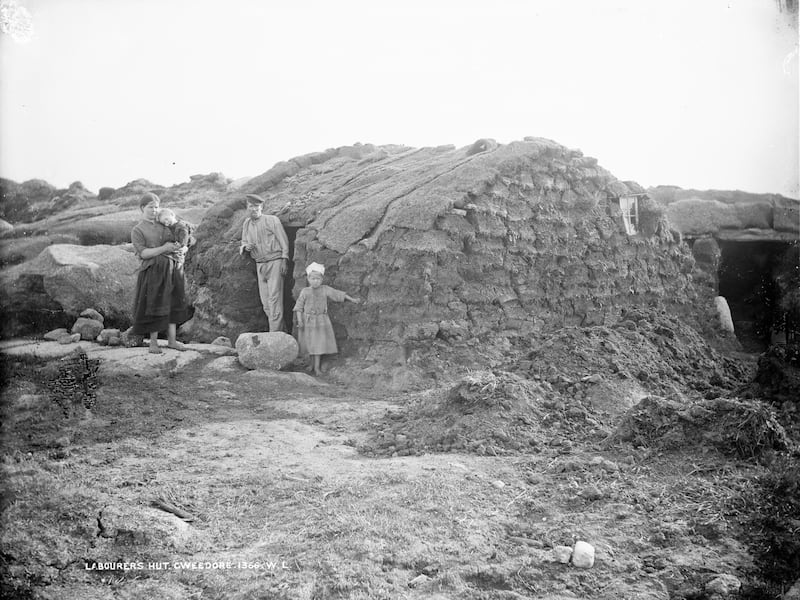In The Land for the People, their small green workbook, Eimear Walshe invites us to consider marriage where acreage is what matters most and to dream up a guest list for a banquet at the recently guerrilla-“liberated” Adare Manor. They also suggest plans for haunting the Instagram-friendly couple who have bought the home from which you were evicted (an eviction that led to your death) and who plan to use it as a holiday home. The artist has thoughtfully provided space for multiple-choice questions, drawings and short essays.
At times laugh-out-loud funny, and always fiercely provocative, Walshe is really asking what ownership means in terms of power and agency. How much does exclusion distort and destroy people’s lives? Who are our laws and policies around land and property actually designed to protect, and how do patterns of ownership steadily increase inequality?
It follows on from the artist’s brilliant film The Land Question: Where the Fuck Am I Supposed to Have Sex?, made for Eva International in 2020. Those familiar with Walshe’s work won’t be surprised at their wry and deeply subversive wit, all underpinned by a wealth of knowledge, worn lightly.
Representing Ireland this year at the Venice Biennale – often described as the Olympics of the art world – their new work, Romantic Ireland, will soon be food for thought for a huge international audience.
RM Block
Homelessness and landlessness are omnipresent actualities for some, and threats for more – the impact they have ripping at the things keeping society and self together. Displacement through climate change and war feed into local polarisations, while on a personal level, as Walshe inexorably lays bare, without a home we lose access to the intimacies that are fundamental to wellbeing. How can you have bodily autonomy when you have no possibility of personal space?
The workbook idea was probably inevitable, they say. Their mother, now retired, was a secondary-school teacher. “You can always tell the child of a teacher. In my case, I think there’s a very, almost camp, pedagogic vibe in almost everything I do. In The Land Question I was trying to be like the weird teacher who is very bad at covering up their motives,” they say, adding that, for themselves, “I learn from people who show through what they’re doing what can be done.”

Walshe may call it camp, and the film is certainly an alternative take on the lecture format, but in the same way that some artists use beauty as their Trojan horse, Walshe commandeers absurdity, which they undercut by being absolutely serious in intent. If to be absurd is to be illogical, where is the logic in selling entire apartment blocks to landlords? If to be absurd is to be unreasonable, what is reasonable about evicting people for not meeting mortgage payments during a recession, selling their property at a cut rate to investors, while still seeking full payment plus arrears? You have to laugh, or else you might cry.
I didn’t have a lot of other fantasies or aspirations. That remains the same now. I’m not entirely confident I could do something else
Chatting with Walshe over a fruity tea at their Temple Bar Gallery studio, I feel oddly inclined to both. Walshe is hugely engaging, with dark eyes, dark hair and a lightness of brilliance. They are one of those people who are brimming with energy yet are not exhausting to be around. They laugh easily, are generous in their praise of artistic partners and collaborators (there are many on their projects), and have that rare ability to own their successes without lurching between the poles of pride and self-deprecation.
They talk about how we use words such as “ordinariness” and “decency”, and how we appear to be programmed to repeat the mistakes of the past, albeit with more contemporary trappings. But just as you might begin to lose hope, they come back with a wry observation, a reference to one of the brilliant people they have worked with, or an idea or approach that is astonishingly creative – and all of a sudden optimism finds a space, however small, to breathe.
Born in Longford, Walshe studied at the National College of Art and Design, then spent time in the Netherlands as part of the prestigious research programme at the Van Abbemuseum (where Annie Fletcher, the director of the Irish Museum of Modern Art, was formerly chief curator). They always knew they were going to be an artist. “I didn’t have a lot of other fantasies or aspirations. That remains the same now. I’m not entirely confident I could do something else.” They returned to Ireland in 2019 to support their father. “I became a full-time carer for him at the end of his life. And I was quite good at that as well,” they say with a lightness that hints at happy memories alongside the encompassing tragedies of death. Their father, who alongside different jobs had been a musician, died in early 2021. “But I was with him, and that’s, like, as big of an achievement as anything in my books.”
We talk about family and about the obsessions that go with being an artist – there is no clocking off at 5pm, and fewer demarcations between work and life and leisure – and from there we go on to ponder the different ways in which each of our individual minds happen to work. Then it’s just a short conversational hop to the impossibility of communicating in such a way as to be sure of what the other person is hearing and understanding. “You could resolve so much worldwide with that. It’s like a combination of being able to broker and understand what you have in common, but also – and this is the holy grail – respect difference,” Walshe says.
They speculate that they inherited their love of touring from growing up around their father’s wedding band, driving from gig to gig. One ongoing project, The Piper’s Grip, sees the artist working with a pair of local musicians in different locations to accompany a reading. As they do this unrehearsed, the process relies on that intuitive magic you only get when empathy is harnessed by creativity. “It might be what they call ‘flow state’,” agrees Walshe. “But sometimes I do feel like I could keep driving around, doing that forever.”

At Venice, Romantic Ireland, which is curated by Sara Greavu and Project Arts Centre, will be installed in the space occupied during previous biennales by Niamh O’Malley, Eva Rothschild, Jesse Jones and Sean Lynch. In this, Walshe is creating a “rammed earth” building, which resembles an Irish cottage that is either falling into ruin or in the process of construction. A small-scale model sits on top of one of their studio speakers. The idea came to them while on one of Common Knowledge’s brilliant Build Schools, run in Kilfenora, Co Clare. “I went there because I just assumed, if I’m going to house myself, I’ll probably have to do it myself, from scratch.”
The idea of rammed-earth building was introduced one afternoon on the course, and Walshe was blown away. “This is the kind of technology and resourcefulness that people had in Ireland. When I started researching it, I found it is 11,000 years old, and there are still standing buildings that were built by presettled people.” Rammed-earth building is created by making a form (think of a mould) into which earth is packed and forced down. Examples exist around the world; in Venice, as well as in each location Romantic Ireland subsequently tours to, local earth will be used.
I have my father as a model for this, because of the dark humour he brought all the way to the grave. It was so inspiring
— Eimear Walshe
The structure will be hung with screens, showing the film that Walshe is, at time of writing, in the process of editing. Filmed on site at Common Knowledge, sequences of masked dancers play across Walshe’s monitors, interpreting and ad-libbing the actions of six individuals, led by the choreographer Mufutau Yusuf, coming together, and falling out, as they attempt to build community, improvise tools and objects, and create home. Over all this plays the sound of Romantic Ireland, by the composer Amanda Feery, to which Walshe has written the libretto.


Creating work for Venice is always going to be tricky. The Irish space is at the end of a long series of exhibition halls in Venice’s historic Arsenale complex, so viewers will come, by definition, to the work tired and with their eyes, and minds, full. You also have no control over what is in the rooms immediately before you, so it is impossible to tune your installation to its surroundings. “There can be a real pressure to scale up production, abandon the DIY aspects, and abandon humour,” says Walshe, remarking that they plan to do none of these things.
[ 2024 in art: 10 shows to look out for over the next 12 monthsOpens in new window ]
“I have my father as a model for this, because of the dark humour he brought all the way to the grave. It was so inspiring. It is,” they add, “a particularly Irish coping mechanism. It’s a survival strategy.” Humour is a useful tool in getting serious points across. “It creates a little gap, or opening, in a subject. It makes your brain and body function differently, so you’re not in a defensive state”, but it can also make things easier to dismiss. In Walshe’s libretto, it is 1943, and a man in his 60s is lying in his bed, dying to the sounds of Éamon de Valera’s St Patrick’s Day speech from that year playing on the radio. Outside, an eviction team have massed to repossess his cottage.
As Dev speaks of happy maidens, sturdy children, cosy homesteads, leisure and frugal comfort, the dying man sings of how the names and accents may have changed but the rich still evict the poor, while the poor’s labour and rents pay for the lifestyles of the wealthy. In Walshe’s text, the 1940s repeat the cycle of the 1840s. You only have to look at the news to see that the repetition continues today, with the added element of scapegoating newcomers, despite our own histories of emigration. “It’s classic divide, rule and conquer,” says Walshe. “But it is actually possible for everyone to have a house, for everyone to have a decent life, and a dignified death,” they say. It is a message that is hugely relevant for Ireland but that also has resonance on a global scale. “That might be one of my main jobs: to open the crack and show there’s maybe just something possible here.”
The 60th Venice Biennale runs from April 20th to November 24th. Ireland at Venice 2024 is an initiative of Culture Ireland in partnership with the Arts Council, with principal sponsorship from Dublin City Council






















